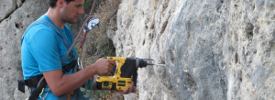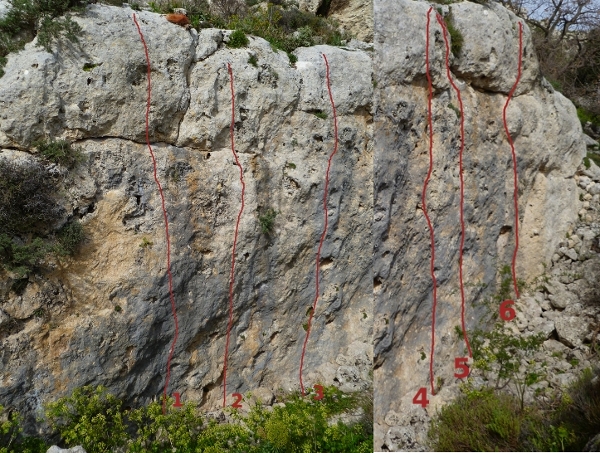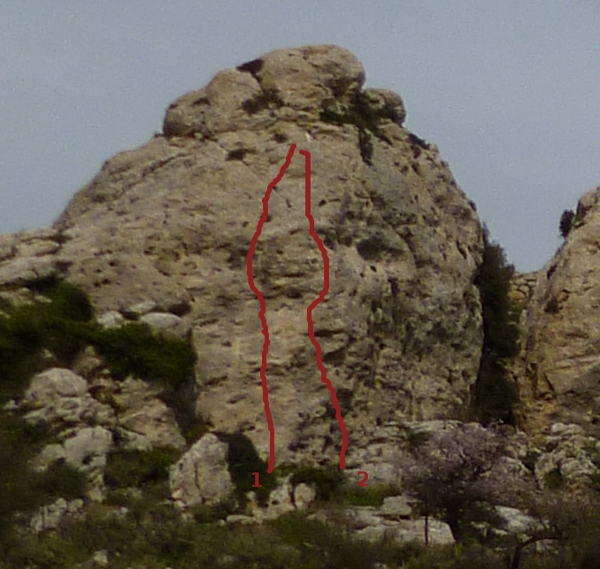Prinias

I was looking something really close to my flat while searching for rocks. I start cycling around the area and found a small cliff, around 8-9 meters and a second one around 18m, well protected from the weather conditions. It is perfect for newbies as all routes (9 in total) are low and easy (5a+/6a+). All routes are equipped with 10mm stainless bolts and belays are ready with two bolts and a ring ready to abseil. You can climb all year long apart from hot summer days due to been in sun most of the day. You need around 30 minutes from Heraklion to Prinias and just 10 from my flat 
Road access
From Heraklion follow the signs for Voutes and Asites. After a few km from Asites you will see a big parking on the left of the road with a large tree in the middle of it. Park there and get your climbing gear off the car! As you are on the parking you will see two faces around 20m each just 100 meters away from the parking. The sector is in front of them, see related gallery to get a better view.
You can also check Google map below to get a better idea how to get to the parking.
Climbing routes
There are 6 routes in this particular sector and two more at the moment to the upper section (see page 2).

Route name: Elbrus
(1) Grade
Grade: 6a+
Length: 8 meters
Protection: 3 bolts. Only your rope and quickdraws needed
Route name: One day after Elbrus
(2) Grade
Grade: 5c+
Length: 8 meters
Protection: 4 bolts. Only your rope and quickdraws needed
Route name: Penny
(3) Grade
Grade: 5b+
Length: 8 meters
Protection: 4 bolts. Only your rope and quickdraws needed
Route name: Sofos
(4) Grade
Grade: 5b+
Length: 8 meters
Protection: 4 bolts. Only your rope and quickdraws needed
Route name: Korina
(5) Grade
Grade: 5b
Length: 9 meters
Protection: 4 bolts. Only your rope and quickdraws needed
Route name: The last, the best
(6) Grade
Grade: 6a
Length: 8 meters
Protection: 4 bolts. Only your rope and quickdraws needed
All belays are equiped with two bolts and a ring.
Sponsored Links: Freshco Flyer, No Frills Flyer, Food Basics Flyer
Sponsored Links: Freshco Flyer, No Frills Flyer, Food Basics Flyer
The second sector of the area is located just a few meters above the small sector previously described.
I'm going to open at least 5 more routes in this sector during the upcoming weeks. Stay tuned!

Route name: Red route
(1) Grade
Grade: 6a+
Length: 18 meters
Protection: Only the belay, will be fully bolted soon.
Route name: Think positive
(2) Grade
Grade: 5c
Length: 18 meters
Protection: Only the belay, will be fully bolted soon.
History
Prinias (ancient Rizinia), Crete, 35 kilometres southwest of Iraklion, about halfway between Gortyn and Knossos, is an archaeological site that has revealed a seventh-century BCE temple with striking similarities to Egyptian architecture, and an Egyptianizing seated goddess. Above the site is a peak sanctuary, a sub-Minoan survival.
Prinias developed at a similar time frame with Lato and Polyrrhenia as an Archaic Period settlement, colonised by Greeks from the mainland. The site contains vestiges of "the first stone buildings since the fall of the Mycenaean kingdoms". Temple A, dated to around 625 BCE, is the earliest known Greek temple decorated with sculpture. Although its plan follows the Mycenaean model, the building had a flat roof and three massive piers on the façade. The most remarkable surviving detail is a limestone lintel bearing two monumental statues of goddesses, seated facing each other. The figures, whose identification is disputed, each wear a long skirt and a cape, reminiscent of the so-called "Lady of Auxerre". Below the figures is an orientalizing frieze representing three panthers on each side; the motif is typical for North Syria.
Temple B is known for its Daedalic sculpture, which "consists of a statue of a goddess seated on a throne and wearing a polos and a stiff garment decorated with animals, a horse, a lion, and a sphinx". The goddess could have represented either Rhea or Artemis as "the mistress of animals". Most of the finds from Prinias (including a singular frieze of horsemen) are conserved at the Archaeological Museum at Heraklion.
Further evidence of Orientalizing culture was extracted from the necropolis which spreads to the west from the ancient town. Some 680 burials (including ritual burials of dogs and horses) were made in the area between the 13th century and 600 BCE. The ritual has Oriental features, with bodies cremated, and heads buried separately.